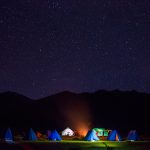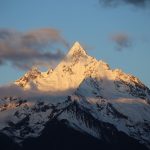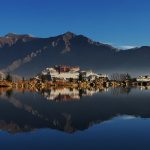Paddling on the Roof of the World
River running and guide training in Tibet
Article by Chris Jones
March 24, 2004
Published on the website www.wetdawg.com
Rafting Tibet
Rafting the Druksum Chu
Photo courtesy of Chris Jones
Shangri-la, the land of snows, the roof of the world, a high altitude desert: from most descriptions of Tibet it is hard to believe that Tibet is home to a large number of spectacular rivers. Mt Kailash in the west of Tibet is the source of the subcontinents four greatest rivers: the Ganges, Indus, Sutlej and Bramaputra. In the east, the forested land of Kham is home to the source of the Mekong and the Yangtse, the two largest rivers in east Asia. In the summer months regular rains swell Tibet’s rivers and the result is a surprising number of world class rafting and kayaking rivers.
Tibetans have used rivers for transport for hundreds of years. Yak skin coracles ferried passengers and goods regularly across the Yarlung Tsangpo and the Lhasa river. Modern river running in Tibet began in the early eighties when intrepid kayakers and rafters began to explore Tibet’s rivers. However, due to travel restrictions and challenging logistics, very little river exploration has been conducted. Boating in Tibet used to be the domain of the high budget expedition or the clandestine dirtbag mission. However, Tibet has now begun to open up. New roads and modern vehicles have made river access easier and river permits are now somewhat easier to procure. The result is an amazing number of world-class rivers just waiting to be explored.
In the summer of 2003 the stars aligned and I was fortunate to get the opportunity to help a Tibetan adventure travel company establish the first Tibet-based river guiding outfit. On the first of July I flew in to Lhasa loaded with 80kg of boating gear. I had no idea what to expect. My first task was to begin training Tibet’s first river guides. I had four trainees who were raring to go but had limited river skills (and questionable swimming skills!) As you can imagine, the first few days of training were fairly amusing. Luckily the boys learned quickly. Three experienced Nepali guides drove up from Katmandu and we quickly formed a multi-cultural team communicating in English, Nepali and our feeble attempts at Tibetan. We conducted much of our introductory training in an outdoor pool in Lhasa. Surrounded by groups of Tibetan and Chinese kids we taught the Tibetans the fundamentals of rafting and kayaking before we moved onto more challenging whitewater.
“No superlatives can really capture the size and power of these rapids. We estimated an approximate 150,000 cfs was thundering through the gorge…”
Over the next six weeks we paddled eight different rivers and creeks, some were first descents while others had been done once or twice before. Within a day’s drive of Lhasa there is an amazingly diverse selection of rivers. The Kyi Chu (Lhasa River) runs right through Lhasa and offers many miles of scenic, easy whitewater. One hour out of Lhasa is the Tolung Chu. This glacial fed run starts as a high altitude stream near amazing hot springs and plunges through a tight gorge before easing up to a friendly class 2/3 run. The higher you go the harder it gets and it can all be road scouted. Northeast of Lhasa is my favorite run. Situated in the stunning Drigung Valley we found 60km of crystal clear, high-altitude river. The upper sections offer class 5 creeking but the lower section offers two days of wonderfully continuous class 3 and 4. Nomads and yaks watched us at the put-in and high above the river to the north, vultures circled a traditional sky-burial site. Before or after the river trip a visit to the Terdom Nunnery and the sublime hot springs is a must.
Further east of Lhasa we paddled a three-day trip on the Kongpo Chu. Once again we started on a high altitude alpine stream that quickly built in volume and turned into a superb class 3/4 run. Towards the end of the second day we encountered a gorge that has four huge rapids. After an hour and a half of scouting and nervous debate, we ran the gorge, perfecting the art of HUGE volume class 5 boating: Stay near the bank and whatever you do, DO NOT get flushed into the center of the river!!
We were having quite a wet season. In Lhasa it rained every single day in July. We had been waiting for the rain to stop so we could get on the Yarlung Tsangpo. Everything we had heard about this river made it sounds like the hardest run in the world, but our maps and old expedition reports indicated we could find some runnable sections. Towards the end of August we finally gave up waiting for the high waters to go down and figured we should go check it out.
Where the Kyi Chu meets the Yarlung the river looks like the Mississippi; flat, muddy and very wide. However, as we drove towards Shigatse the nature of the river changes. The river banks close in and a huge gorge forms near the town of Nyemo. We scouted as much as we could. The rapids were huge. From the road we thought we could see lines but as we pulled out the binoculars and got closer to the river we realized the true size of the rapids. No superlatives can really capture the size and power of these rapids. We estimated an approximate 150,000 cfs was thundering through the gorge and locals told us the river was running unseasonably high for this time of year. We wisely drove out of the gorge with the boats firmly strapped to the roof. Perhaps next season the water will be lower!
We headed closer to Shigatse and found somewhat tamer water. A far cry from the alpine rivers we had been running for the past few weeks, the Yarlung here was still a powerful monster of a river. The huge waves dwarfed our kayaks and made our 14ft raft look like a bathtub toy. It felt more like sea kayaking then whitewater boating! The river was moving so fast it only took us just over three hours to paddle just under 50km!
September came around far too quickly and I had to meet commitments back in Canada. My two months in Tibet were, by far, the most unique paddling adventure I have ever undertaken. On our final night in Lhasa the Tibetan trainees took us out on the town to celebrate their success and my departure. We had already run ten commercial trips and two of the guys could now roll and paddle class 3 water. With a hazy head I flew out of Lhasa the next morning. My flight path took me out over the wild forested regions of eastern Tibet. Even from 30,000 feet I could see multitudes of rivers cascading through the forests just waiting to be explored and paddled.
Postscript
An international group of kayakers is planning to complete the first descent of the remote and wild Yigong Tsangpo River in central Tibet. Lead by Australian kayaker, Chris Jones, the team of professional kayakers and photographers includes Australian freestyle paddler Georgia LePlastrier, Australian Olympic hopeful, Justin Boocock and English freestyle and extreme paddler, Ed Cornfield. The team meets in Katmandu on 27th April to begin the arduous four day drive through the Himalaya to Lhasa, the capital of Tibet. The Yigong Tsangpo is another two days drive north of Lhasa.
The team hopes to navigate the entire length of the river from its source on the Tibetan Plateau, 275km to its confluence with the Po Tsangpo. The middle section of the river is expected to provide the biggest challenge with 140km of remote and challenging whitewater. The team expects to find class 4 and 5 whitewater and is preparing for up to 3 weeks on the water. A support crew will hike the rough terrain along the river-bank, restocking the kayakerÕs supplies and providing a safety back up. After the completion of the river the team will spend up to one month exploring other rivers and helping train the first Tibetan river guides.
The expedition is currently supported by www.kokatat.com, www.tibetwindhorse.com, www.liquidlogickayaks.com, www.teva.com, www.wildequipment.com.au, www.northwater.com, www.FNAheadgear.com, www.adventurepro.com.au, www.wernerpaddles.com.





